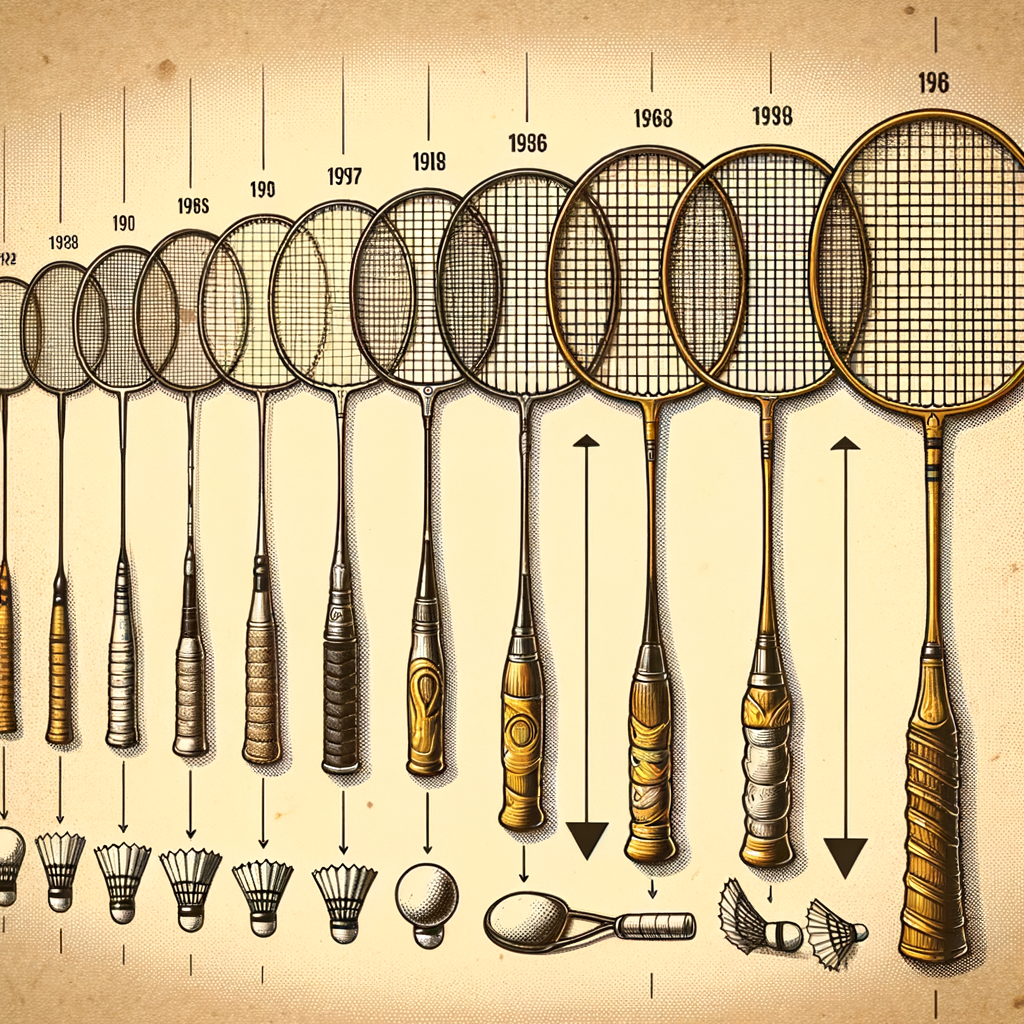
Introduction to the Evolution of Badminton Rackets Over the Decades
Badminton is a sport enjoyed by many people around the world. Over the years, the equipment used in badminton has changed a lot. One of the most important pieces of equipment is the badminton racket. Understanding how these rackets have evolved can help us appreciate the game even more.
- Overview of the evolution of badminton equipment: Badminton rackets have come a long way from their early days. They used to be made of wood, but now they are made of advanced materials like carbon fiber. These changes have made the rackets lighter and stronger.
- Importance of understanding the history of badminton rackets: Knowing the history of badminton rackets helps us see how technology has improved the game. It also shows us the creativity and innovation that have gone into making the sport better for players.
History of Badminton Rackets
Vintage Badminton Rackets
- Design and materials of early badminton rackets:In the early days, badminton rackets were made from wood. The frames were often crafted from ash wood, which is strong yet flexible. The strings were made from animal gut, usually from sheep. These rackets were heavier and less durable compared to modern ones.
- Key manufacturers in the early days:Some of the first companies to make badminton rackets were Dunlop and Slazenger. These companies were well-known for their sports equipment. They played a big role in popularizing badminton as a sport.
Changes in Badminton Racket Design Over Time
- Shift from Wooden to Metal RacketsIn the early days, badminton rackets were made of wood. These wooden rackets were heavy and not very durable. Over time, manufacturers started using metal to make rackets. Metal rackets were lighter and stronger, making them more popular among players.
For example, in the 1960s, the introduction of aluminum rackets marked a big change. Players found these rackets easier to handle, which improved their game.
- Introduction of Synthetic MaterialsAs technology advanced, synthetic materials like carbon fiber and graphite were introduced. These materials made rackets even lighter and more durable. Carbon fiber rackets are very popular today because they offer great strength and flexibility.
For instance, Yonex, a leading badminton racket manufacturer, started using graphite in the 1980s. This change helped players hit the shuttlecock with more power and control.
- Changes in Racket Shape and SizeNot only did the materials change, but the shape and size of rackets also evolved. Early rackets had small, oval heads. Modern rackets have larger, isometric heads. This change provides a bigger sweet spot, making it easier to hit the shuttlecock accurately.
Additionally, the length of the racket has increased slightly over the years. This gives players a better reach and more leverage for powerful shots.
| Era | Material | Shape | Key Manufacturer |
|---|---|---|---|
| Early 1900s | Wood | Small, Oval | Unknown |
| 1960s | Aluminum | Small, Oval | Various |
| 1980s | Graphite | Larger, Isometric | Yonex |
| Present | Carbon Fiber | Larger, Isometric | Yonex, Li-Ning |
Modern Badminton Racket Technology
Advances in Badminton Racket Materials
Over the years, badminton rackets have seen significant improvements. These changes have made the game more exciting and accessible for players of all levels.
- Use of carbon fiber and other high-tech materialsModern badminton rackets often use carbon fiber. This material is very strong and light. Other high-tech materials like graphite and titanium are also used. These materials help make rackets more durable and easier to handle.
- Impact of material advances on racket performanceNew materials have greatly improved racket performance. Players can now hit the shuttlecock faster and with more control. The lightweight nature of these materials reduces arm fatigue, allowing for longer play sessions.
| Material | Benefit |
|---|---|
| Carbon Fiber | Strong and lightweight |
| Graphite | Durable and flexible |
| Titanium | High strength and stability |
Badminton Racket Innovation
-
Introduction of Isometric Head Shape
The isometric head shape is a game-changer in badminton. Unlike traditional oval-shaped rackets, the isometric design has a larger sweet spot. This means players have a better chance of hitting the shuttlecock perfectly. Yonex, a leading brand, introduced this shape in the 1980s. Today, many players prefer isometric rackets for their improved accuracy and power.
-
Development of Flexible Shafts
Flexible shafts are another important innovation. These shafts bend more during a swing, storing energy. When the racket hits the shuttlecock, the stored energy is released, adding extra power to the shot. This technology is especially helpful for players with slower swings. Flexible shafts make it easier to hit powerful shots without using too much strength.
-
Advancements in String Technology
String technology has also come a long way. Modern strings are made from high-tech materials like synthetic gut and multifilament. These strings offer better control and durability. Some strings are designed to provide more spin, while others focus on power. Players can choose strings based on their playing style. For example, professional players often use strings that offer a good balance of power and control.
| Innovation | Benefit | Example |
|---|---|---|
| Isometric Head Shape | Larger sweet spot | Yonex rackets |
| Flexible Shafts | More power with less effort | Used by players with slower swings |
| String Technology | Better control and durability | Synthetic gut strings |
Development of Badminton Rackets: Case Studies
-
Case Study: Yonex’s Development of the First Carbon Fiber Racket
Yonex is a well-known brand in badminton. In the 1980s, they made a big change in racket design. They created the first carbon fiber racket. This was a game-changer.
Carbon fiber is very strong but also very light. This made the rackets easier to handle. Players could swing faster and hit harder. The new material also made the rackets more durable.
Before carbon fiber, rackets were made of wood or metal. These materials were heavier and less flexible. Yonex’s new design helped players improve their game. It set a new standard in the industry.
Feature Before Carbon Fiber After Carbon Fiber Material Wood/Metal Carbon Fiber Weight Heavy Light Durability Less Durable More Durable Yonex’s innovation showed how new materials could change sports equipment. It was a big step forward in badminton technology.
-
Case Study: Carlton’s Introduction of the Isometric Head Shape
Carlton is another famous brand in badminton. In the 1990s, they introduced a new racket design. They called it the isometric head shape.
Traditional rackets had oval-shaped heads. Carlton changed this to a more square shape. This new design had a bigger sweet spot. The sweet spot is the best place to hit the shuttlecock. A bigger sweet spot means more accurate shots.
Players found it easier to control their shots with the isometric head. It helped them play better, especially during fast games. This design became very popular and is still used today.
Feature Traditional Head Isometric Head Shape Oval Square Sweet Spot Smaller Bigger Control Less Control More Control Carlton’s isometric head shape showed how changing the design could improve performance. It was a smart move that helped many players.
Badminton Racket Trends and Future Developments
-
Current Trends in Badminton Racket Design and Technology
Badminton rackets have seen many changes in recent years. One major trend is the use of lightweight materials. Modern rackets are often made from carbon fiber. This makes them strong yet light.
Another trend is the improved grip design. New grips help players hold the racket better. This means fewer slips and better control.
Technology also plays a big role. Some rackets now have built-in sensors. These sensors can track your swings and provide data. This helps players improve their game.
Trend Details Lightweight Materials Use of carbon fiber for strength and lightness Improved Grip Design Better grip for control and fewer slips Built-in Sensors Track swings and provide data -
Predicted Future Developments in Badminton Rackets
The future of badminton rackets looks exciting. Experts predict even more advanced materials will be used. These materials could make rackets even lighter and stronger.
Another future trend could be smart rackets. These rackets might connect to apps on your phone. They could give real-time feedback during a game.
There is also talk of customizable rackets. Players might be able to adjust the weight and balance of their racket. This would make each racket perfect for its user.
Future Development Details Advanced Materials Even lighter and stronger materials Smart Rackets Connect to apps for real-time feedback Customizable Rackets Adjust weight and balance for each player
Conclusion: The Impact of Badminton Racket Evolution
The evolution of badminton rackets has significantly influenced the game. Let’s explore how these changes have shaped badminton and highlight key takeaways from the history of racket development.
- How the evolution of badminton rackets has changed the game:Over the years, badminton rackets have become lighter and stronger. This has allowed players to hit the shuttlecock faster and with more precision. Modern materials like carbon fiber have replaced wood, making rackets more durable and easier to handle.
These advancements have led to quicker games and more exciting rallies. Players can now perform powerful smashes and delicate drop shots with greater ease. The evolution of rackets has also made the sport more accessible to younger and less experienced players.
- Key takeaways from the history of badminton racket development:
- Material Changes: From wood to carbon fiber, materials have played a crucial role in racket performance.
- Design Improvements: Modern rackets have better grip and balance, enhancing player control.
- Technological Advances: Innovations like isometric head shapes have increased the sweet spot, making it easier to hit the shuttlecock.
| Era | Material | Impact |
|---|---|---|
| Early 1900s | Wood | Heavy and less durable |
| Mid 1900s | Metal | Stronger but still heavy |
| Late 1900s | Graphite | Lighter and more flexible |
| 2000s | Carbon Fiber | Lightweight and very strong |
The evolution of badminton rackets has made the game faster and more enjoyable. Understanding the history and development of these rackets helps us appreciate the sport even more. As technology continues to advance, we can expect even more exciting changes in the future of badminton.
